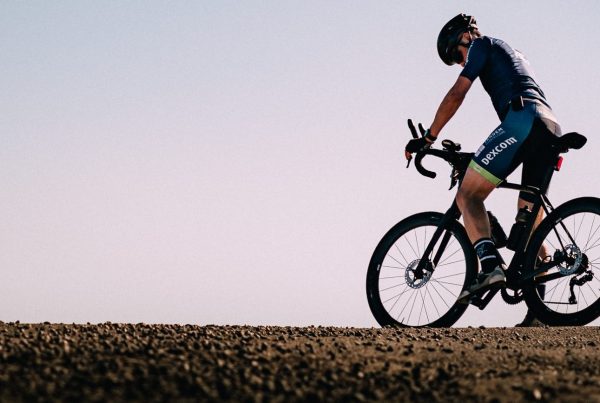Believe me, this isn’t my first storm. In August 2006, I spent a night at an altitude of 6,000 meters in Kyrgyzstan, on all fours, spread-eagled at the four corners of my tent to keep it on the ground so as not to be blown away by the wind.
On another expedition, I was informed by radio that two of my climbing partners were turning back. At the same time, I was standing next to a frozen body. It was on Mount Everest.
Similarly, my 2014 cross-Canada run wasn’t exactly a breeze. To be clear, 180 marathons in 9 months is difficult and painful, from the second marathon onwards.
Over the years, I’ve noticed that while no crisis is pleasant, if we willingly choose adversity from time to time, it becomes easier to manage the unexpected that hits us from behind. So here’s what I’ve learned about resilience, in order to succeed in changing environments, before, during and after a storm.
1. Avoid plans that are too linear. The easiest thing to do is to set goals. It takes a minute, and we all do it on January 1. The problem is that all too often, our strategy looks like a straight line; five simple steps to the goal. As a result, our plan too rarely includes something like: “Step # 4: Upsetting element beyond my control”.
Resilience isn’t just about how we solve problems. It’s also our way of anticipating and planning for contingencies. By trying to anticipate the unknown before it happens, we make it easier to tackle. Resilience means preparing for the most predictable part of any journey: obstacles, disappointments and sometimes sheer sadness.
2. Accept rather than win. My first reaction when I was diagnosed with type 1 diabetes, the most severe form of the disease, was to fight. I wanted to win and be stronger than my condition. I became obsessed with controlling my blood sugar and obsessive about all the good practices of disease management. Although my control was exemplary at the time, coexisting with one’s sworn enemy proved to be an exhausting way to live one’s life. Resilience sometimes means accepting rather than overcoming. With acceptance, my condition became my greatest ally. By being open to what she could teach me, I was able to grow, and my illness even became an advantage. It enabled me to acquire the discipline and rigor needed to carry out major projects.
3. The size of your toolbox is important. Let’s be clear: we can’t outwit the mountain. Despite all our preparation, our scenarios never turned out the way we’d imagined. That said, our preparation enabled us to make the climb with a much larger toolbox, making it possible to solve bigger problems. What’s more, our previous failures, when accepted, also enable us to perfect our toolbox. To climb the world’s highest mountains, you need expertise and experience. Experience and resilience are what you get when you don’t get what you want.
4. Resilience is built before a crisis. Here’s my favorite quote: “Happiness is in the effort made“. Resilient organizations and individuals are always willing to make the effort, whether there’s a crisis or not. They find pleasure in complexity and challenge, and satisfaction in hard work. Along the way, they develop the conviction that no matter what the pitfalls, they’ll find a way to succeed. Their culture and actions are also more focused on learning from the journey, rather than on the pleasures of the finish line. Resilience is a muscle. It’s not an object we acquire, it’s a practice to which we commit ourselves.
5. Save energy. Endurance sport is all about planning your resources according to kilometers and time remaining. While the onset of a crisis corresponds to the urgency to act, the next step is to find the right rhythm. The period of confinement and its challenges, as well as the recovery that follows, constitute a marathon. From emergency to recovery, we now need to plan our energy to win in the long term. Beware of those who sprint too early! Victory will go to those organizations that take the necessary steps today, with calmness, consistency and strategy, to win at the end of the year.
6. Resilience is patience. Just because you can’t see the summit right now, doesn’t mean it’s gone. Resilience doesn’t give up when it loses sight of the summit. During a storm, be patient and stay focused on the long term. Climbing Mount Everest is a two-month process that involves more waiting than climbing.
7. Adapt, but don’t overreact. During a crisis, you have to adapt, period. That said, it’s important not to make things worse. That’s why, if you’re lost in the woods, rescue experts advise you to stay in one place until help arrives. Deal with current problems, prepare for the most predictable ones and, above all, avoid creating them in your head. If you’re in a management position, it’s your responsibility to make your employees feel safe. This is often achieved by solving real and immediate problems quickly, keeping an eye on the organization’s mission and remaining focused on a long-term goal. In other words, provide the right mix of comfort and vision.
In conclusion
All my great sporting achievements began with a commitment to a complex challenge full of uncertainties and obstacles. I haven’t always succeeded, but I’ve built up a lot of resilience over the years.
Resilience is a delayed gratification. It means sweating now for a reward later. Move from urgency to recovery with this simple question: what do I need to do today to succeed in the new normal, post-Covid-19?
Soon, we’ll be back to our usual activities at a faster pace, trying to make up for our losses. As our collective memory is sometimes short, it could then become easy to forget what we’ve learned, and that wouldn’t be resilient.
I hope you have found this reading useful. Literally, it took me decades of sweat and scrapes to acquire this knowledge. Now it’s your turn to use them!
Good luck!



